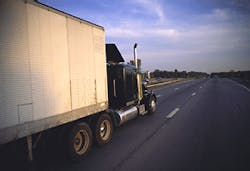TAMPA, FL. The Federal Motor Carrier Safety Administration (FMCSA) expects to issue its long-awaited notice of proposed rulemaking (NPRM) concerning electronic on board recorders (EOBRs) of driver logbooks – the so–called “black boxes” by May or June. Here at the Technology & Maintenance Council annual meeting, an FMCSA official said the agency is deciding whether such technology should be implemented on a mandatory or voluntary basis.
“We recognize there are limits to what EOBR technology can do, so our rulemaking process is allowing us to get comments from the industry, safety groups, even public citizens, to help us decide how to use this technology – or even use it at all,” said Larry Minor, director of the office of bus and truck safety and operations for FMCSA.
FMCSA has received 307 comments on its initial rulemaking notice concerning EOBR technology issued back in Sept. 1, 2004, Minor said.
“One reason we didn’t include a requirement for this technology in our revision of hours of service (HOS) regulations for commercial drivers is that we didn’t fully understand the capability of technology involved, nor the issues involved with its implementation,” he said. One big unknown is cost, he noted, with prices ranging from $300 to $4,100 per unit.
“That’s why we want more comments,” Minor said. “We’re relying on you to tell us what bottom line impact this technology could have. Your feedback is especially important for us to estimate the costs of this technology and barriers to its implementation. Also, no final decision about EOBR use is going to result from this NPRM – all possible things may still happen after it’s published.”
Brian McLaughlin, manager of product strategy for PeopleNet, said the trucking industry continues to weigh many pros and cons about EOBRs. On the one hand, fleets could use EOBRs to reduce their risk of non-compliance with HOS rules, reduce administrative paperwork related to logbooks, save drivers the hassle of filling in logbooks, and give dispatchers a more accurate way to gauge driver availability.
Yet many negatives remain, McLaughlin said. “First and foremost, there’s a perceived lack of driver acceptance of EOBRs and fear they could lose drivers over it,” HE said, noting privacy issues. “Both managers and drivers fear what kinds of information could be exposed by the technology to law enforcement and regulators. There’s also the cost vs. benefit factor, as there’s a cost to installing this technology, training people to use it, etc.
“This technology could enable trucking not only to improve safety but also business practices as well,” McLaughlin added. “That’s why we plan to continue studying this technology closely.”
About the Author
Sean Kilcarr
Editor in Chief
Sean Kilcarr is a former longtime FleetOwner senior editor who wrote for the publication from 2000 to 2018. He served as editor-in-chief from 2017 to 2018.
